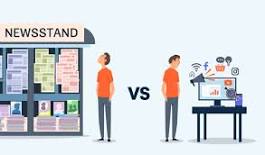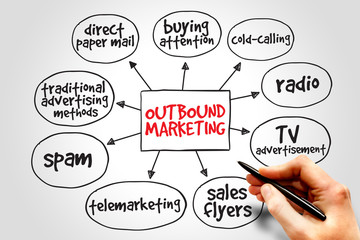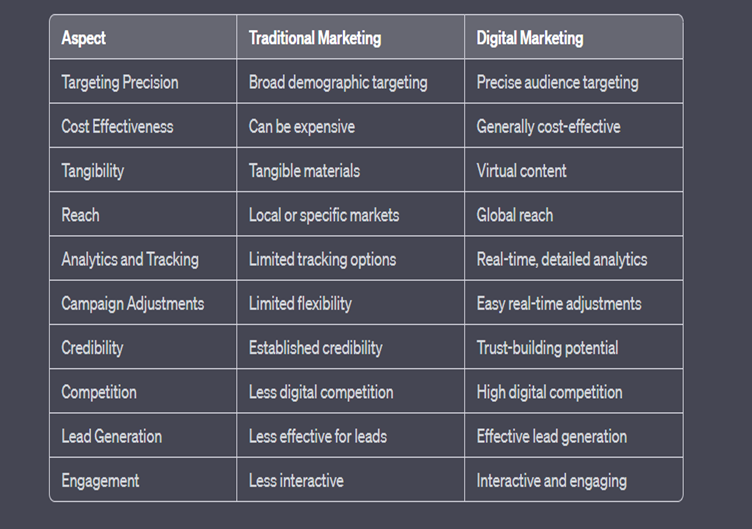In today’s fast-paced digital age, marketing has evolved significantly. Strategy to Follow to compare and act to optimise marketing.
The traditional marketing methods that once dominated the industry have been challenged by the rise of digital marketing. We need to work with the right Strategy to select Traditional or Digital Marketing.

As businesses strive to connect with their target audiences effectively, they often find themselves at a crossroads: Should they stick with the tried-and-true methods of traditional marketing or embrace the dynamic world of digital marketing?
In this article, we’ll compare traditional and digital marketing approaches to help you make the right strategy decision for your business.
Traditional Marketing

Traditional marketing encompasses the conventional advertising methods that have been used for decades. These methods include:
Print Advertising: This includes newspaper and magazine ads, brochures, flyers, and direct mail campaigns. It’s a tangible and familiar form of advertising.
Broadcast Advertising: Television and radio commercials are classic examples of broadcast advertising. They have wide reach but can be costly.
Outdoor Advertising: Billboards, posters, and transit ads are part of outdoor marketing. They can be highly visible in specific locations.
Events and Sponsorships: Participating in or sponsoring events, trade shows, and sports teams allows businesses to connect with their audience in person.
Pros of Traditional Marketing:
Tangibility: Traditional marketing materials can be physically held and are often more memorable for some audiences.
Local Reach: Traditional methods can be effective in reaching local markets and specific demographics.
Established Credibility: Some consumers trust traditional media more than digital sources.
Cons of Traditional Marketing:
Limited Targeting: Traditional marketing is less precise in reaching specific demographics compared to digital methods.
Higher Costs: Producing and distributing print or broadcast materials can be expensive.
Limited Analytics: It’s harder to track the effectiveness of traditional marketing campaigns accurately. Make a Strategy and then act!
Digital Marketing Strategy

Digital marketing leverages online channels and technology to reach and engage with target audiences. Key components of digital marketing include:
Social Media Marketing: Utilizing platforms like Facebook, Instagram, and Twitter to connect with audiences, run ads, and build brand awareness. All these study deeply to make Strategy.
Content Marketing: Creating valuable content such as blog posts, videos, and infographics to attract and engage potential customers.
Email Marketing: Sending targeted emails to subscribers and potential customers to promote products or services.
Search Engine Optimization (SEO): Optimizing website content to improve search engine rankings and visibility.
Pay-Per-Click (PPC) Advertising: Placing ads on search engines and websites and paying only when someone clicks on them.
Pros of Digital Marketing:
Precise Targeting: Digital marketing allows you to target specific demographics, interests, and behaviors.
Cost-Effective: Many digital marketing methods are budget-friendly, especially for small businesses.
Real-time Analytics: You can track campaign performance in real time, making it easier to adjust strategies for better results.
Global Reach: Digital marketing can reach a vast global audience.
Cons of Digital Marketing:

Constant Evolution: Digital marketing channels and algorithms change frequently, requiring businesses to adapt continually.
Competition: With low entry barriers, the digital space is highly competitive.
Information Overload: Consumers are bombarded with digital ads and content, making it challenging to stand out.
Certainly, here’s a table summarizing the key points of comparison between traditional marketing and digital marketing:
Strategy to Follow:
Choosing the correct marketing path for your business involves careful consideration of your goals, audience, and resources. Here are five strategies to help you make an informed decision:
Understand Your Audience: Start by thoroughly researching your target audience. Consider factors like age, interests, online behavior, and preferred communication channels. If your audience predominantly uses digital platforms, digital marketing might be more effective. If they are older and less tech-savvy, traditional methods may still have value.
Set Clear Goals: Define specific, measurable, achievable, relevant, and time-bound (SMART) marketing goals. Are you aiming to increase brand awareness, generate leads, boost sales, or enhance customer loyalty? Your objectives will guide your choice between traditional and digital marketing. For example, if your goal is to reach a wider, younger audience, digital marketing is likely the better choice.
Budget Assessment: Analyze your marketing budget. Traditional marketing methods like TV commercials and print ads can be cost-prohibitive for some businesses. Digital marketing, on the other hand, often offers more cost-effective options. Determine how much you can allocate to marketing and evaluate which strategies fit within your budget.
Competitive Analysis: Research your competitors to see what marketing strategies they are using. Identify gaps or areas where you can differentiate yourself. If your competitors are heavily invested in digital marketing and you have a unique approach for traditional marketing, that could be a strategic advantage.
Testing and Iteration: Consider running small-scale tests before committing to a full-scale marketing strategy. For instance, you could run a targeted Facebook ad campaign alongside a local newspaper ad for a limited time. Measure the results and analyze which approach yields better returns on investment. Based on the data, you can make informed decisions about where to allocate your resources.
Remember that in many cases, a hybrid approach that combines both traditional and digital marketing can be the most effective. The key is to regularly evaluate your strategies, track performance, and be willing to adjust your approach based on real-time data and changing market conditions.
Tools and Techniques in Traditional and Digital Marketing
Introduction
Marketing has undergone a profound transformation in recent years, largely driven by the advent of digital technology.
Traditional marketing methods are still relevant, but they now coexist with a vast array of digital tools and techniques. In this article, we will explore some of the most essential tools and techniques associated with both traditional and digital marketing, highlighting their respective strengths and how they can be integrated for a comprehensive marketing strategy.
Traditional Marketing Tools and Techniques to Implement Strategy
Print Advertising:
Brochures and Flyers: These are versatile tools for conveying information about your products or services in a tangible format. Design and print quality play a crucial role in their effectiveness.
Newspaper and Magazine Ads: Print publications are still widely read, especially in specific demographics. Placing ads in newspapers and magazines can reach local and niche audiences effectively.
Direct Mail: Sending promotional materials, such as postcards or catalogs, through the mail allows for targeted marketing campaigns.
Broadcast Advertising:
Television Commercials: TV ads remain a powerful way to reach a broad audience, making them suitable for branding and mass market campaigns.
Radio Commercials: Radio ads can be cost-effective and are particularly effective for local or regional promotions.
Outdoor Advertising:
Billboards: Placing eye-catching billboards along busy highways or in strategic locations can capture the attention of passing motorists and pedestrians.
Transit Advertising: This includes ads on buses, trams, and taxis. It’s an excellent way to gain exposure in urban areas.
Events and Sponsorships:
Trade Shows and Exhibitions: Participating in industry-related events allows businesses to showcase their products and services directly to a targeted audience.
Sponsorships: Associating your brand with events or organizations can boost brand recognition and loyalty.
Digital Marketing Tools and Techniques
Social Media Marketing:
Facebook: Allows businesses to create and manage pages, run ads, and engage with users through posts, comments, and messenger.
Instagram: Ideal for visual marketing, with a focus on images and short videos.
Twitter: Useful for real-time updates and engagement with a wide audience.
LinkedIn: Primarily for B2B marketing, helping to establish professional connections and share industry-related content.
Content Marketing:
Blogging: Creating informative and engaging blog posts can attract organic traffic and position your brand as an authority in your industry.
Video Marketing: Platforms like YouTube offer opportunities to create and share videos, which are highly engaging and shareable.
Infographics: Visual content that presents data and information in a digestible format, often shared across social media.
Email Marketing:
Email Campaign Software: Tools like Mailchimp and Constant Contact help businesses create, send, and analyze email campaigns.
Personalization: Segmenting email lists and sending personalized content increases open rates and conversions.
Search Engine Optimization (SEO):
Keyword Research Tools: Tools like SEMrush and Ahrefs assist in finding relevant keywords and optimizing content for search engines.
On-Page SEO: Techniques such as optimizing meta titles, descriptions, and image alt text improve search engine rankings.
Backlink Analysis: Analyzing and building high-quality backlinks can boost a website’s authority.
Pay-Per-Click (PPC) Advertising:
Google Ads: Allows businesses to bid on keywords and display ads in Google search results and on affiliated websites.
Social Media Ads: Platforms like Facebook, Instagram, and LinkedIn offer ad options for various marketing objectives, including lead generation and sales.
Integration of Traditional and Digital Marketing
Cross-Promotion:
Utilize digital channels to promote traditional marketing efforts. For instance, create teaser videos for upcoming TV commercials and share them on social media.
Include QR codes or short URLs in print materials that lead to digital content or offers.
Data Analytics:
Implement analytics tools across all marketing efforts to measure performance. Use this data to refine strategies and allocate resources effectively.
Incorporate call tracking for traditional advertising to assess its impact on lead generation and conversions.
Consistent Branding:
Maintain consistent branding elements, such as logos, colors, and messaging, across both traditional and digital channels. This builds brand recognition.
Ensure that your website and social media profiles reflect the same brand identity presented in print materials and other traditional media.
Audience Engagement:
Encourage engagement across all channels. Use social media to initiate conversations and discussions related to your print or broadcast campaigns.
Incorporate user-generated content from digital platforms into traditional advertising materials.
Leverage Influencers:
Collaborate with social media influencers who align with your brand to promote both traditional and digital marketing efforts.
Invite influencers to attend or promote events and sponsorships related to your traditional marketing campaigns.
Conclusion
In today’s marketing landscape, the line between traditional and digital marketing is increasingly blurred.
The most successful businesses recognize the need for a holistic approach that leverages the strengths of both worlds. By carefully selecting the right tools and techniques from traditional and digital marketing, and integrating them strategically, businesses can reach their target audiences effectively, build brand loyalty, and achieve their marketing goals.
Adaptability and a deep understanding of your audience remain key factors in crafting a successful marketing strategy in this ever-evolving landscape
Following points should provide a quick overview of the main differences between traditional and digital marketing methods. Remember that the effectiveness of each approach can vary depending on your business, target audience, and marketing goals.

These points should provide a quick overview of the main differences between traditional and digital marketing methods. Remember that the effectiveness of each approach can vary depending on your business, target audience, and marketing goals.
Conclusion for Strategy to Follow
Comparison
Traditional marketing and digital marketing each have their strengths and weaknesses. The choice between them depends on various factors, including your target audience, budget, and business goals.
In many cases, a combination of both traditional and digital marketing can be the most effective strategy. Traditional methods can build credibility and trust, while digital methods offer precision and cost-efficiency.
In today’s interconnected world, understanding the nuances of both traditional and digital marketing is essential for crafting a successful marketing strategy.
By carefully evaluating your unique business needs and the preferences of your target audience, you can strike the right balance between these two approaches to maximize your marketing efforts.
Know More